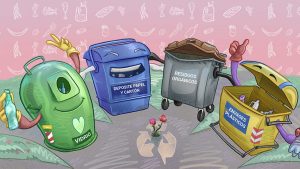
RTVE
Hoy, 17 de mayo se celebra el Día Mundial del Reciclaje con la finalidad de concienciar a la población sobre la importancia de tratar y clasificar los residuos como corresponden para poder proteger el medio ambiente.
RTVE, hace cuatro años, publicó un spot utilizando la metáfora de un cuento para mandar un mensaje de la necesidad de reducir el volumen de los residuos generados y minimizar nuestra huella de carbono. Pincha aquí para visualizar el vídeo.
Por otro lado, la gran herramienta que ayuda al correcto tratamiento de residuos es la llamada “Regla de las Tres Erres”:
- Reducir: intentar comprar productos que tengan el mínimo envasado posible. Utilizar bolsas de tela o llevar nuestras propias bolsas al mercado también es una opción que ayuda a reducir la fabricación de plásticos.
- Reutilizar: se trata de dar una nueva vida a las cosas que ya no sirven. Desde Cátedra UNESCO Forum Universidad y Patrimonio Cultural y también desde n nuestro proyecto, se realizan cursos de tintes naturales para utilizar los desperdicios generados en nuestras cocinas y así, poder teñir nuestras prendas, ofreciéndoles un nuevo uso.
- Reciclar: casi todos los materiales que utilizamos pueden ser reciclados. Esto depende tanto de las instituciones, como de nosotros mismos. Un dato importante es que el reciclaje de 1.000 kg de papel es capaz de salvar la vida de 17 árboles.
Si tienes que separar o tirar residuos y depositarlos en los contenedores correspondientes, esto es lo que debes saber:
- Contenedor azul: papel y cartón.
- Contenedor amarillo: envases (botellas, bolsas, latas). Limpia antes los envases y aplástalos para disminuir su volumen.
- Contenedor verde: vidrio. Limpiar antes los envases y quita las tapas.
- Contenedor marrón: residuos orgánicos.
- Contenedor gris: restos no reciclables.
Desde estas pequeñas acciones, podemos construir un futuro más sostenible, favoreciendo a mares y océanos y a nuestro planeta, en general.
__
WORLD RECYCLING DAY
Today, May 17, World Recycling Day is celebrated with the aim of raising awareness of the importance of treating and sorting waste properly in order to protect the environment.
Four years ago, RTVE published a spot using the metaphor of a story to send a message about the need to reduce the volume of waste generated and minimize our carbon footprint. Click here to view the video.
On the other hand, the great tool that helps the correct treatment of waste is the so-called “Three Wrongs Rule”:
1. Reduce: try to buy products that have as little packaging as possible. Using cloth bags or taking our own bags to the market is also an option that helps to reduce the manufacture of plastics.
2. Reuse: it is about giving a new life to things that are no longer useful. From the UNESCO Chair Forum University and Cultural Heritage and also from our project, we offer courses on natural dyes to use the waste generated in our kitchens to dye our clothes, offering them a new use.
3. Recycle: almost all the materials we use can be recycled. This depends both on the institutions and on ourselves. An important fact is that the recycling of 1,000 kg of paper is capable of saving the life of 17 trees.
If you have to separate or dispose of waste and deposit it in the corresponding containers, here is what you should know:
– Blue container: paper and cardboard.
– Yellow container: containers (bottles, bags, cans). Clean the containers before and crush them to reduce their volume.
– Green container: glass. Clean the containers first and remove the lids.
– Brown container: organic waste.
– Gray container: non-recyclable waste.
From these small actions, we can build a more sustainable future, favoring seas and oceans and our planet, in general.
__

